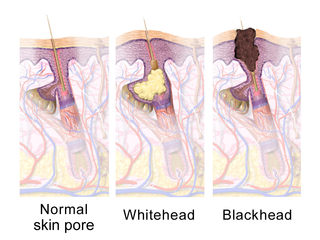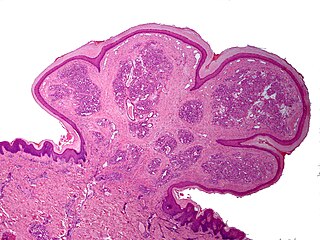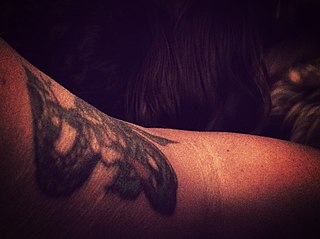Dermatology is the branch of medicine dealing with the skin. It is a speciality with both medical and surgical aspects. A dermatologist is a specialist medical doctor who manages diseases related to skin, hair, nails, and some cosmetic problems.

A birthmark is a congenital, benign irregularity on the skin which is present at birth or appears shortly after birth—usually in the first month. Birthmarks can occur anywhere on the skin. They are caused by overgrowth of blood vessels, melanocytes, smooth muscle, fat, fibroblasts, or keratinocytes.
Intense pulsed light (IPL) is a technology used by cosmetic and medical practitioners to perform various skin treatments for aesthetic and therapeutic purposes, including hair removal, photorejuvenation as well as to alleviate dermatologic diseases such as acne. IPL is increasingly used in optometry and ophthalmology as well, to treat evaporative dry eye disease due to meibomian gland dysfunction.

Laser hair removal is the process of hair removal by means of exposure to pulses of laser light that destroy the hair follicle. It had been performed experimentally for about twenty years before becoming commercially available in 1995–1996. One of the first published articles describing laser hair removal was authored by the group at Massachusetts General Hospital in 1998. Laser hair removal is widely practiced in clinics, and even in homes using devices designed and priced for consumer self-treatment. Many reviews of laser hair removal methods, safety, and efficacy have been published in the dermatology literature.

A port-wine stain is a discoloration of the human skin caused by a vascular anomaly. They are so named for their coloration, which is similar in color to port wine, a fortified red wine from Portugal.
Dermabrasion is a type of surgical skin planing, generally with the goal of removing acne, scarring and other skin or tissue irregularities, typically performed in a professional medical setting by a dermatologist or plastic surgeon trained specifically in this procedure. Dermabrasion has been practiced for many years and involves the controlled deeper abrasion of the upper to mid layers of the skin with any variety of strong abrasive devices including a wire brush, diamond wheel or fraise, sterilized sandpaper, salt crystals or other mechanical means.

A comedo is a clogged hair follicle (pore) in the skin. Keratin combines with oil to block the follicle. A comedo can be open (blackhead) or closed by skin (whitehead) and occur with or without acne. The word "comedo" comes from the Latin comedere, meaning "to eat up", and was historically used to describe parasitic worms; in modern medical terminology, it is used to suggest the worm-like appearance of the expressed material.

A pyogenic granuloma or lobular capillary hemangioma is a vascular tumor that occurs on both mucosa and skin, and appears as an overgrowth of tissue due to irritation, physical trauma, or hormonal factors. It is often found to involve the gums, skin, or nasal septum, and has also been found far from the head, such as in the thigh.

Richard Rox Anderson, FAAD, is a Boston-based dermatologist and entrepreneur.

Tattoo removal is the process of removing an unwanted tattoo. The process of tattooing generally creates permanent markings in the skin, but people have attempted many methods to try to hide or destroy tattoos.
Ava T. Shamban is an American celebrity dermatologist who has made numerous appearances on television and cosmetic publications as an authority on the subject. She is currently a board-certified dermatologist based in Los Angeles, and founder of Ava MD.
Cosmetic camouflage is the application of make-up creams and/or powders to conceal colour or contour irregularities or abnormalities of the face or body. It offers an answer to solve all related skin problems such as Congenital origin, Traumatic origin and Dermatological origin. Furthermore, cosmetic camouflage solves the psychological problems that a skin imperfection is sometimes able to provoke, it allows to rediscover its own beauty and to return with serenity to its own social life. Cosmetic camouflage creams were first developed by plastic surgeons during World War II to cover the massive burns received by fighter pilots. Nowadays, men, women and children can use cosmetic camouflage.
Roy G. Geronemus is an American dermatologist in the field of laser treatment of skin disorders.
Photorejuvenation is a skin treatment that uses lasers, intense pulsed light, or photodynamic therapy to treat skin conditions and remove effects of photoaging such as wrinkles, spots, and textures. The process induces controlled wounds to the skin. This prompts the skin to heal itself, by creating new cells. This process—to a certain extent—removes the signs of photoaging. The technique was invented by Thomas L Roberts, III using CO2 lasers in the 1990s. Observed complications have included scarring, hyperpigmentation, acne, and herpes.
Alchimie Forever is an anti-aging skin care line by Swiss dermatologist Dr. Luigi Polla.

Laser medicine is the use of lasers in medical diagnosis, treatments, or therapies, such as laser photodynamic therapy, photorejuvenation, and laser surgery.
Aesthetic medicine is a branch of modern medicine that focuses on altering natural or acquired unwanted appearance through the treatment of conditions including scars, skin laxity, wrinkles, moles, liver spots, excess fat, cellulite, unwanted hair, skin discoloration, spider veins and or any unwanted externally visible appearance. Traditionally, it includes dermatology, oral and maxillofacial surgery, reconstructive surgery and plastic surgery, surgical procedures, non-surgical procedures, and a combination of both. Aesthetic medicine procedures are usually elective. There is a long history of aesthetic medicine procedures, dating back to many notable cases in the 19th century, though techniques have developed much since then.

Mitchel P. Goldman, is an American dermatologic surgeon, cosmetic surgeon, dermatologist, and phlebologist, and the founder and director of Cosmetic Laser Dermatology. He is also a past president of the American Society for Dermatologic Surgery, the American College of Phlebology, the San Diego County Dermatology Society, and the Sonoran Dermatology Society.

Azeezia Medical College Hospital is a private hospital located in Kerala. It is a 540-bed multi-specialty hospital. The hospital provides treatment in various specialties, such as medicine, surgery, obstetrics and gynecology, dermatology, psychiatry, pediatrics, orthopedics, ophthalmology, otolaryngology, anesthesiology, radiology, emergency services, and laparoscopic surgery. Super-specialty departments include cardiothoracic, neurology, nephrology, pulmonology, gastroenterology, endocrinology, and neurosurgery. The private medical college includes super-specialty units and colleges for medical, dental, and nursing courses. The campus is in a rural area eight km (5.0 mi) from NH-47.
Nicholas J Lowe is an English dermatologist who has published research into skin pharmacology, botulinum toxins, injectable filler and Lasers in cutaneous and cosmetic Surgery.









